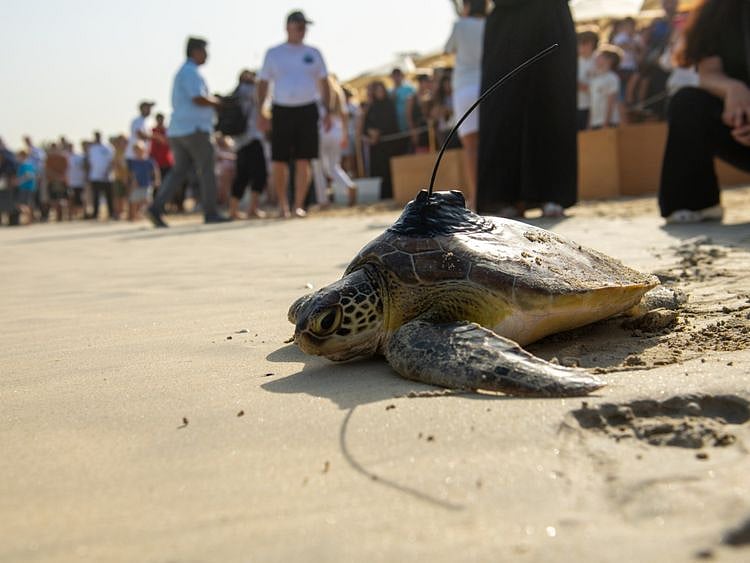Watch: Zippy, 20 other rescued turtles released in UAE waters
Dubai Turtle Rehabilitation Project holds event near Bur Al Arab hotel

Dubai: Several endangered turtles have been rehabilitated in Dubai and released into the Arabian Gulf.
They were released yesterday, World Sea Turtle Day, as part of Jumeirah Group’s Dubai Turtle Rehabilitation Project. The 15 Hawksbill and six Green Turtles, both of which are considered endangered species, made it to the sea Jumeirah Al Naseem beach next to the iconic Bur Al Arab hotel.
Dedicated to the preservation of endangered turtle species, the Dubai Turtle Rehabilitation Project focuses on the conservation of the hawksbill turtle, a critically endangered species that annually nests along the Gulf coast.
Among the successfully rehabilitated turtles was a large female green turtle which had suffered carapace damage due to a boat strike, as well as a male hawksbill turtle named Zippy. Zippy was rescued by the Dubai Turtle Rehabilitation Project in October 2022, after being found in bad shape floating near the Ras al Khaimah shoreline and reported via the 800 TURTLE helpline. Zippy suffered intestine impaction from eating plastic debris, a severe lung infection and was completely covered in barnacles.
The event was hosted by Katerina Giannouka, CEO at Jumeirah Group. In her welcome speech, she said: “With many of our resorts being coastal, both here in the Middle East as well as in Europe, Indonesia and the Maldives, we witness first-hand the impact of climate change on precious marine species and these delicate ecosystems.”
Giannouka added: “Coastal resilience and biodiversity health are critical to Jumeirah as a business and for the tourism and hospitality sector globally. We have an obligation to act now, to educate, to collaborate, and to champion progress towards a sustainable future for all.”
The event was attended by key partners including government representatives, academia and non-governmental organisations (NGOs). Also in attendance were representatives from Yas Sea World Research and Rescue, who performed a CT scan on Zippy at the start of his remarkable rehabilitation journey.
Barbara Lang-Lenton Arrizabalaga, director of Aquarium at Burj Al Arab Jumeirah, said: “With such a limited number of these turtles left, it is essential to ensure that every one of them can fulfil its role in maintaining population numbers. It was critical for us to release our adult sea turtles as soon as they fully recovered.”
Also Read
Abu Dhabi urges residents to report turtle nesting on beaches, protect animalsKnow Abu Dhabi’s protected areas, home to a huge variety of plants and animalsThe National Aquarium and EAD rescue, rehabilitate and release over 500 sea turtlesAbu Dhabi expands sea turtle rehabilitation project with new dedicated lagoon at the LouvreSatellite tagging
She added: “We have already released several turtles this season, and we can see from our satellite tagging programme that some of these animals have travelled to their nesting sites. As beach temperatures rise due to climate change, the sex ratio of sea turtles is shifting towards a higher number of females being born. The reintroduction of a fully grown male hawksbill turtle like Zippy marks a significant milestone for sea turtle conservation in the UAE and globally.”
The satellite tagging programme conducted by the Dubai Turtle Rehabilitation Project has yielded valuable data showcasing the project’s global impact on turtle populations. Notably, the team successfully traced the journey of a rescued Olive Ridley turtle, which is occasionally encountered in UAE waters, back to crucial nesting sites for the species in India. Previous data has also shown a green turtle migrating as far as Thailand, demonstrating the importance of rehabilitation and release to maintaining sea turtle populations worldwide.
“The goal is to ensure that turtles receive the best care possible. Building inter-emirate cooperation across the UAE’s scientific communities, rescue centres and government entities enables us to undertake a mutually beneficial cooperation in sea turtle rehabilitation, research, and habitat restoration,” said Arrizabalaga.
“With the support of the UAE community, Jumeirah’s Dubai Turtle Rehabilitation Project continues to have a positive impact on turtle rehabilitation, contributing to the conservation of these threatened species.”
Building on its commitment to the protection of marine biodiversity and ecosystems, Jumeirah Group also recently hosted a three-day Ocean Climate retreat, the Marrakech Partnership for Global Climate Action (MPGCA) Ocean & Coastal Zones. The event was attended by Razan Al Mubarak, President of the International Union for Conservation of Nature (IUCN) and UN Climate Change High-Level Champion for COP28. Focused on addressing the importance of the ocean climate nexus for the hospitality sector, the retreat brought together high level COP28 climate champions, experts and leaders from MPGCA Ocean & Coastal Zones, World Wildlife Fund International and Emirates Nature-WWF.
About the project
Jumeirah Group has been successfully tending to sick or injured sea turtles since the inception of its dedicated programme in 2004, in collaboration with Dubai’s Wildlife Protection Office (WPO), the Dubai Falcon Hospital and the Dubai Central Veterinary Research Laboratory. With annual rescue figures averaging over 100 sea turtles, the most predominant species tended to in the facility include Hawksbill and Green turtles, while Loggerhead and Olive Ridley turtles are occasionally brought in.
The project also runs an educational programme for school groups to learn more about the work undertaken at the Dubai Turtle Rehabilitation Project, the importance of these incredible creatures and the threats they face in their survival. Taking place between October and April, over 1,700 school children from all seven emirates have participated this season. Hotel guests and visitors can also learn more about sea turtles and their conservation, witness their recovery and even participate in feeding at dedicated, state-of-the-art sea-fed turtle lagoon at Jumeirah Al Naseem.
Sign up for the Daily Briefing
Get the latest news and updates straight to your inbox
Network Links
GN StoreDownload our app
© Al Nisr Publishing LLC 2025. All rights reserved.